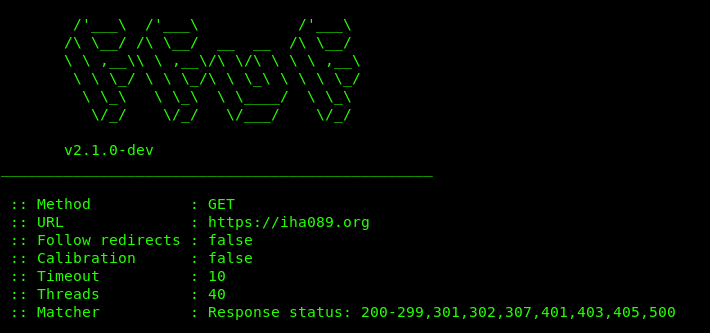Hey, fellow bug hunters and security nerds! As a seasoned penetration tester, I’ve spent countless hours digging through web apps, chasing those elusive vulnerabilities that make bug bounties so thrilling. One tool that’s been a game-changer in my arsenal is Ffuf—short for Fuzz Faster U Fool. It’s not just another directory buster; it’s a fuzzing beast that lets you probe URLs, headers, parameters, and more with surgical precision. In this post, I’m sharing my go-to advanced Ffuf commands and pro tips, honed from real-world pentests and bug bounty hunts. Whether you’re sniffing out hidden endpoints or chasing critical CVEs, this guide will help you wield Ffuf like a pro.

Table of Contents
Why Ffuf is My Secret Weapon
I’ve messed around with tools like dirb and Gobuster, but Ffuf is on another level. It’s not just about blasting directories—it’s about fuzzing anything and everything in a web app. URLs, headers, parameters—you name it, Ffuf can poke it.
- Fuzz Anywhere: Stick the
FUZZkeyword in URLs, POST data, or headers to test whatever you want. - Wordlist Power: Combine multiple wordlists to hit complex targets hard.
- Filter Like a Boss: Cut through junk responses with status codes, sizes, or regex.
- Config Hacks: Save time with custom setups for your pentest gigs.
This guide’s got my favorite Ffuf commands and hacks I’ve used to unearth hidden APIs, config files, and even a few CVEs.
Starting Simple: Ffuf Basics
Before we go full hacker mode, let’s cover the basics. If you’re new to Ffuf, this is how you kick things off:
ffuf -w /usr/share/wordlists/seclists/Discovery/Web-Content/common.txt -u https://target.com/FUZZThe -w flag points to your wordlist (SecLists is my jam), and FUZZ is where Ffuf swaps in each word. It’s like knocking on every door of a website to see which ones open.
Grab quickhits.txt from SecLists for a fast, focused scan. It’s small but punches above its weight.
Advanced Ffuf Commands to Crush It
Alright, let’s get to the juicy stuff—advanced commands I’ve used to find hidden gems in real pentests.
1. Ditching Noise with Status Code Filters
Fuzzing spits out a ton of responses, and half of ‘em are useless 404s or 301s. To keep your sanity, filter ‘em out:
ffuf -w /usr/share/wordlists/seclists/Discovery/Web-Content/common.txt -u https://target.com/FUZZ -fc 404,301The -fc flag skips those pesky status codes. Want to dig deeper? Add recursion to chase subdirectories:
ffuf -w /usr/share/wordlists/seclists/Discovery/Web-Content/common.txt -u https://target.com/FUZZ -fc 404,301 -recursion -recursion-depth 2Recursion follows discovered paths, and -recursion-depth 2 keeps it from going overboard.
2. Snagging Hidden Files with Extensions
Backup files like .bak or .env are hacker candy. To hunt them down, use the -e flag:
ffuf -w /usr/share/wordlists/seclists/Discovery/Web-Content/common.txt -u https://target.com/FUZZ -e .php,.bak,.envOr, for extra control, use a separate extension list:
ffuf -w /usr/share/wordlists/seclists/Discovery/Web-Content/common.txt -u https://target.com/FUZZ.EXT -w /path/to/extensions.txt:EXTAlways throw in .conf, .sql, and .txt to your extension list.
3. Sneaking Past Defenses with Headers
Some servers are picky and block generic requests. To look legit, spoof your User-Agent:
ffuf -w /usr/share/wordlists/seclists/Discovery/Web-Content/common.txt -u https://target.com/FUZZ -H "User-Agent: Mozilla/5.0 (Windows NT 10.0; Win64; x64) AppleWebKit/537.36"For pentests, I add custom headers to tag my traffic:
ffuf -w /usr/share/wordlists/seclists/Discovery/Web-Content/common.txt -u https://target.com/FUZZ -H "X-Hunter-ID: bounty2025"4. Filtering by Response Size
Ever get spammed with identical error pages? Filter them by size:
ffuf -w /usr/share/wordlists/seclists/Discovery/Web-Content/common.txt -u https://target.com/FUZZ -fs 1500The -fs 1500 skips responses with 1500 bytes. Combine it with status filters for max clarity:
ffuf -w /usr/share/wordlists/seclists/Discovery/Web-Content/common.txt -u https://target.com/FUZZ -fc 404 -fs 1500Use this to skip generic 404s and find unique pages, like an exposed admin login.
5. Laser-Focused Directory Hunting
Want to zero in on juicy directories like /admin or /api? Use -acc:
ffuf -w /usr/share/wordlists/seclists/Discovery/Web-Content/common.txt -u https://target.com/FUZZ -ac -acc /admin -acc /apiThis focuses your fuzzing on those paths, saving time and server stress.
6. Parameter Fuzzing for Big Wins
Parameters are where bugs like IDOR or SQLi hide. Fuzz them like this:
ffuf -w /usr/share/wordlists/seclists/Discovery/Web-Content/burp-parameter-names.txt -u https://target.com/?id=FUZZ&user=test -fc 200This tests the id parameter while keeping user static, skipping 200 OK responses to find oddballs.
7. Brute-Forcing with Character Sets
For login pages or tokens, limit payloads to specific characters:
ffuf -w /usr/share/wordlists/seclists/Usernames/top-usernames-shortlist.txt -u https://target.com/login -X POST -d "username=FUZZ&password=test123" -c a-z0-9The -c a-z0-9 keeps it to lowercase letters and numbers, making your brute-force leaner.
Used this to enumerate usernames on a login page. Pair with a short wordlist to avoid lockouts.
8. Saving Results for Later
Don’t lose your findings in terminal chaos. Save them in JSON:
ffuf -w /usr/share/wordlists/seclists/Discovery/Web-Content/common.txt -u https://target.com/FUZZ -o results.json -of jsonThe -o sets the output file, and -of json keeps it structured.
9. Staying Stealthy with Timing
Fuzzing too fast can get you banned. Slow it down:
ffuf -w /usr/share/wordlists/seclists/Discovery/Web-Content/common.txt -u https://target.com/FUZZ -p 0.5-1.5 -t 25The -p 0.5-1.5 adds a random delay, and -t 25 limits threads to 25.
Pro Hacks for Ffuf Mastery
Config Files to Save Time
Typing the same options is a pain. Save them in ~/.ffufrc:
[general]
colors = true
[http]
proxyurl = "http://127.0.0.1:8080"
headers = ["X-Hunter-ID: bounty2025"]Run with:
ffuf -config ~/.ffufrc -w /usr/share/wordlists/seclists/Discovery/Web-Content/common.txt -u https://target.com/FUZZSeparate configs for each client. Saves me hours on big pentests.
Dynamic Payloads with STDIN
For creative fuzzing, pipe payloads from seq or cook:
seq 1 500 | ffuf -u https://target.com/?id=FUZZ -w -For path traversal:
cook '../*1-6' | ffuf -u https://target.com/?file=PT/etc/passwd -w -:PT -vAvoiding False Negatives
Ffuf defaults to status codes like 200 and 403, but you might miss 201 or 429. Catch everything:
ffuf -w /usr/share/wordlists/seclists/Discovery/Web-Content/common.txt -u https://target.com/FUZZ -mc all -fc 404For proxy noise (like .htaccess), use regex:
ffuf -w /usr/share/wordlists/seclists/Discovery/Web-Content/common.txt -u https://target.com/FUZZ -mc all -fr '/\..*'Raw Requests for Complex Targets
For tricky APIs, use a raw request file (req.txt):
GET /api?token=FUZZ HTTP/1.1
Host: target.com
User-Agent: Mozilla/5.0
Accept: */*Run:
cook 1-500 | ffuf -request req.txt -w - -request-proto httpChaos Fuzzing with Radamsa
For wild fuzzing, use Radamsa to mutate payloads:
ffuf --input-cmd 'echo "user@target.com" | radamsa --seed $FFUF_NUM' -input-num 50 -u https://target.com/api -X POST -d '{"email":"FUZZ"}' -H "Content-Type: application/json"This creates 50 email variations to test input handling.
Bug Hunter’s Code of Ethics
- Smart Wordlists: Use
raft-medium-files-lowercase.txtto keep scans lean. - Filter Hard: Stack
-fc,-fs, and-frfor clean results. - Stay Legal: Respect bug bounty scopes and rate limits.
- Analyze Fast: Pipe outputs to
greporjqfor quick wins. - Practice: Hit up TryHackMe’s Ffuf room or the
ffufmeDocker image.
Wrap-Up: Fuzz Like a Bounty Legend
Ffuf’s my trusty sidekick for finding hidden endpoints, misconfigs, and juicy bugs. With these advanced Ffuf commands, configs, and hacks, you’re ready to dominate web security testing and bug bounty fuzzing. Fire up TryHackMe or ffufme to practice, and let’s keep the hunt ethical and fun. Got a bug? Go get that bounty!
Advanced Ffuf Techniques for Web Security and Bug Bounty Success


